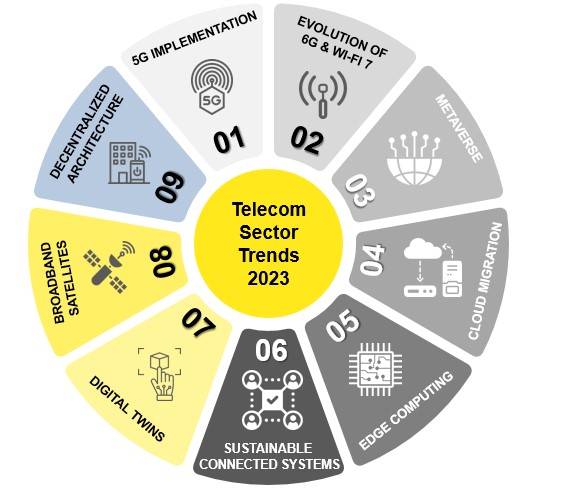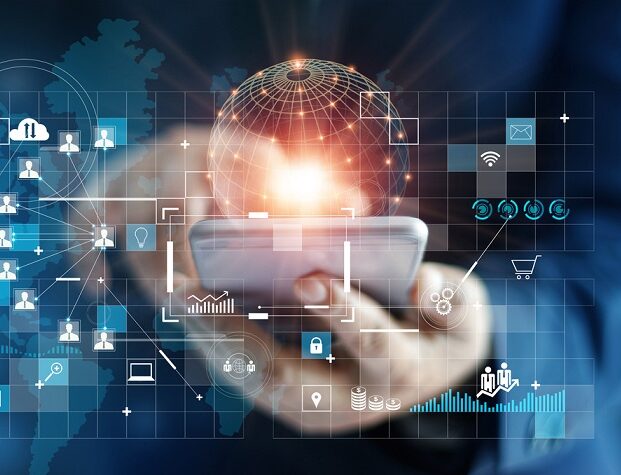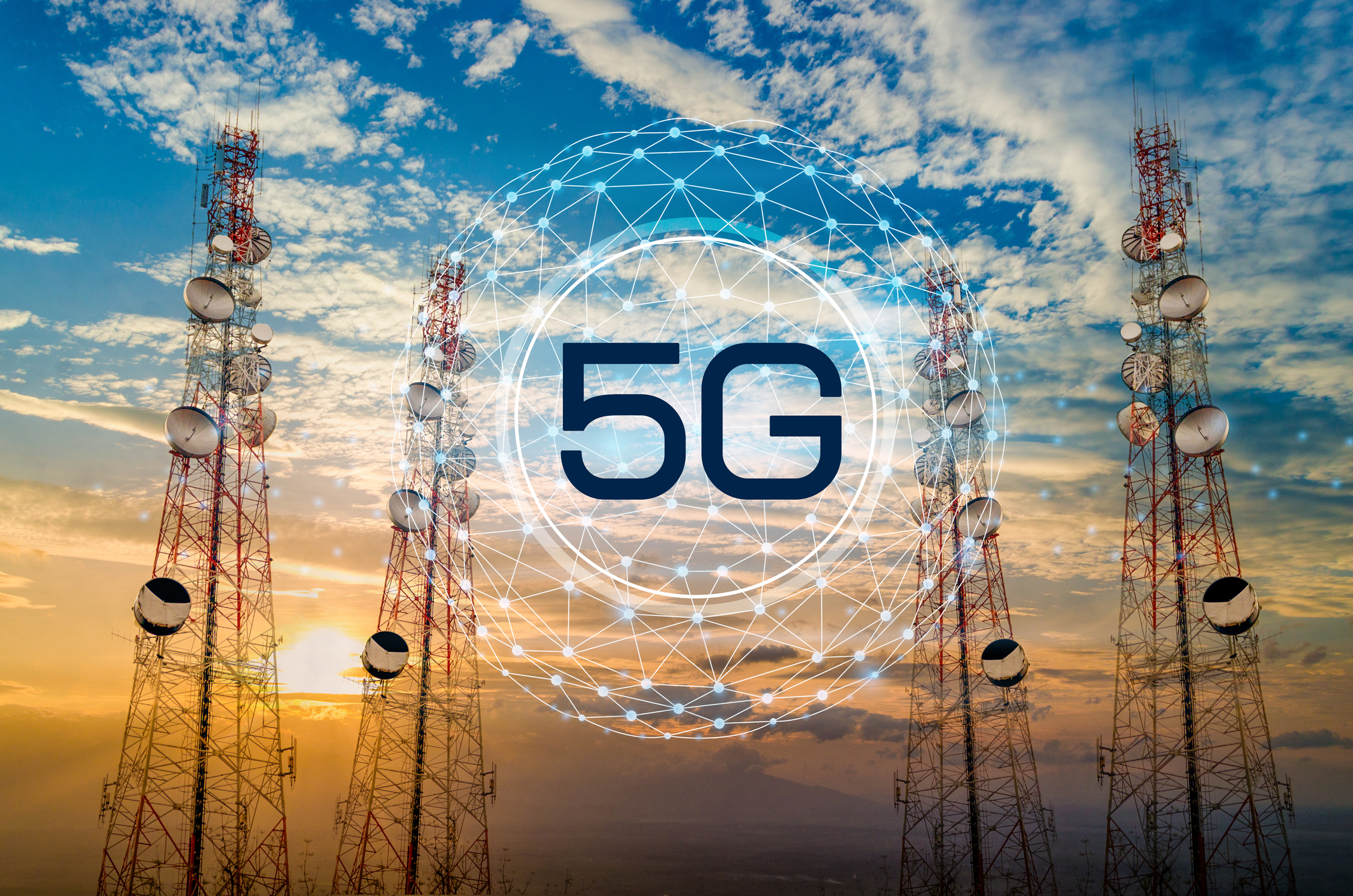Telecom Industry Outlook 2023

Figure 1: Telecom Sector Trends
Future uncertainty in the telecom industry is rising due to quick technological changes, legislation, and consumer demand. However, industry employees who embrace innovation, rethink their network service capabilities, and drive growth will discover even more extensive opportunities than ever before.
As we approach 2023, the telecom sector has evolved and will continue to change. Telecom is undergoing a digital transition in technology, driving the industry and directing how it engages with customers, thanks to the acceleration of IoT and 5G.
Digital disruption already underway was amplified by the COVID-19 pandemic, necessitating the development of customer-focused services and increased effectiveness.
Know About Networks
- 5G Implementation: In 2023, 5G will finally become a part of our daily lives (on a global scale), and telecom companies will start realizing their commercial value. The revenues earned will facilitate further investment in BSSs and 5G networks. The incoming 5G will give a significant push to IoT infrastructure. It is found in various sectors, including smart industries, homes, grids, cities, and healthcare, expanding its reach significantly. Thus, enabling a new wave of services and applications. Telecom companies will underscore all these developments through intense diversification, new billing systems, and monetization strategies. Most importantly, it will allow them to overcome their mistakes during 4G implementation.

- Evolution of 6G and Wi-Fi: The rollout of 5G will lay the foundation for next-level connectivity. There is already much talk about the technologies that will define 6G, but everyone agrees that it will fix the limitations set by 5G. It is expected that 6G will work along the lines of sustainability goals, fostering reliability and trust and connecting the remotest parts of this planet. Along with this, the Wi-Fi 7 standards development process will pace up and probably release in 2024. The new Wi-Fi will support 8K and 4K resolution videos, cloud computing, and virtual connectivity techs like augmented and virtual reality.
Metaverse Technology
Metaverse might be the answer to accelerating the pace of behavioral, functional, and operational changes in our society. Upon fruition, it will transform the world around us within a generation. It will impact telecommunications, connectivity, and all other verticals the most. However, it still has a long way to go and won’t be part of our current world in 2023. Although much groundwork has already been laid to bring it to the mainstream world, changing the telecom world precisely unless the service requirements are ubiquitously made available will make it difficult to experience the full-fledged benefits. With huge investments, we may expect severe changes in the telecom metaverse industry within 2-3 years.

Deep Impact of Technology
- Cloud migration: A recent Gartner report suggests that over 85% of organizations will use a cloud-first approach to deploy applications in the coming year. The simplification of network infrastructure is compelling companies worldwide to adopt cloud migration. This juggernaut of cloud technology benefits the telecom sector in various ways. It provides better revenue opportunities, scalability, agility, flexibility, and lower operational costs and sustainability. Telecom companies can finally start working on customizing their offerings and developing better relationships with their end-users. In 2023, we will see several top-tier companies amalgamating fixed lines and mobile telcos with cloud-based services, allowing real-time communication from any device and location.
- Edge computing becomes more significant: Edge computing provides a platform for enabling and hosting application execution at the network’s edge. Edge cloud computing tech will become a rage rapidly as CSPs deploy 5G networks filled with countless distributed and central cloud-edge sites. As 5G evolves into a business imperative, its role will take center stage. There will be an increasing need to connect cloud services and benefits with IIoT applications and industrial devices. The proximity between edge cloud and edge computing will enable low latency, reliability, and availability. This is especially beneficial for latency-sensitive, high-bandwidth use cases like AR/VR, IIoT, and Industry 4.0.
Sustainable Methods
- Sustainable Connected Systems: Content delivery and storage haven’t been eco-friendly procedures lately. The demand for energy and water is bound to increase with the rising level and complexity of telecom technologies. This puts the telecom sector, which is moving towards being an entirely data-centric industry, in a tight spot. It’s become necessary to look at alternate energy sources and practices, particularly those with less carbon footprint. There is a rising interest in renewable energy sources that will start replacing traditional energy sources by 2023-24. Solar and wind energy, the primary role models in this sphere, will bring the change, enabling a smaller carbon footprint for telecom companies and better connectivity in areas without electricity. Most importantly, renewable sources will help narrow overall operational energy costs, which is a significant expense for this sector.
- The emergence of Digital Twins: In the telecom industry, digital twins virtually replicate network applications and services. It includes using several real-time data sources, like edge clouds, subscriber data, IoT devices, ML data lakes, etc. Digital twins combined with machine learning help estimate the effects and challenges associated with different scenarios without their physical implementation. The rapid adoption of digital twins will help CSPs accelerate their digital transformation and rapidly resolve complications arising from 5G use cases. It will allow telecom companies to develop a fresh perspective on the interrelationship between processes, networks, and end-users. For instance, Nokia Core Networks uses digital twins to develop self-healing and anomaly prediction capacity in networks, network function software updates, visual network planning, energy consumption, cost simulations, etc. Siemens, GE, and several others are also using DTs in various capacities, and this trend is expected to evolve in 2023 and beyond.
Detailed Classification
- Digitization of supply chains: We cannot just talk about digital twins and leave out supply chains or “smart” supply chains from the equation. These are the answers to finding and eliminating major disruptions that impact industries’ overall operational efficiency and revenue figures. Digitization will help companies work in increasingly unpredictable times where customer, regulatory, and technological demands constantly evolve, and complications increase daily.
- Cyber security and resilience: As data breaches and cyberattacks rise, they raise questions about the resilience and cybersecurity of the telecom industry. The number of threats and attacks will rise in the coming year as 5G touches more lives. Companies have already begun addressing this problem, and significant developments and innovations are expected in this area in the coming years. Anticipated roles in this regard include blockchain and cloud migration, which play vital roles. The rising adoption of these technologies in 2023 indicates the industry’s efforts to tackle the challenges effectively. Verizon Media Services, for example, recently deployed a cloud-based application firewall (WAF) that addresses the increasing cybersecurity threats in the telecom sector.
- More inclination towards decentralized architectures: Decentralized architectures are taking center stage as companies realize the need to secure user communications and transaction information. Technologies like Decentralized Ledger Technology (DLT) frameworks keep records encrypted, immutable, and tamper-proof.
- Surge In broadband satellites: A recent Deloitte report predicts that over 5000 broadband satellites will join Low-Earth’s Orbit (LEO) by the end of 2023. If the numbers keep rising similarly, by 2030, the LEO may have 40-50 thousand satellites – in what we call a “mega constellation” topology. The dawn of 5G will elevate device-to-satellite connectivity to new heights, connecting millions living in the remotest areas with the global community. However, mitigating the risks of satellite collision and overcrowding requires close coordination among national and global players.
Final Word
Maintaining market leadership may pose challenges for telecom companies. Factors such as varying rates of 5G adoption and the increasing demand for sustainable business practices contribute to these challenges. Furthermore, the need for advanced analytic solutions further increases the complexity. Regardless of the evolving world, we must prioritize sustainability to ensure future generations can enjoy it. Experts consider the topical changes, such as 6G, cloud migration, supply chain digitization, and edge computing, as best practices. These practices help in reducing our carbon footprint and promoting sustainability. Stellarix helps companies to excel in the telecom sector. So, contact us.



